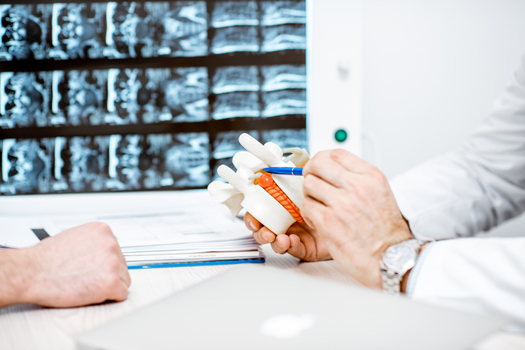
It's reasonable to expect treatment for a herniated disc (also commonly known as a "slipped disc" or “ruptured disc”) to eliminate or ease your discomfort, especially if a doctor recommends surgery to resolve your sciatica or other disc-related symptoms. However, there are times when issues related to a damaged spinal disc return sometime later. Below, we take a closer look at how common this problem (referred to as “reherniation”) really is when the lower or lumbar spine is affected.
Disc Removal Surgery Itself Has a Fairly High Success Rate
Surgery to remove a herniated disc has a generally high success rate. According to the journal Medicine, success rates for lumbar discectomies range from 70 to 90 percent. However, there’s a common issue to be aware of.
Reherniation Is a Common Lumbar Discectomy Complication
Reherniation is considered the most common complication following a lumbar discectomy. According to some sources, anywhere from 7 to 18 percent of patients who've had discectomies later experience issues with recurrent disc herniation. The National Institutes of Health puts reherniation rates between 5 and 15 percent. However, as we will discuss, patients with a large hole left in their disc following surgery have significantly higher chances of reherniation—and women under 50 years old have up to 10 times the average risk of reherniation.
Several Factors Play a Role in Reherniation Risk
The risk of disc reherniation and reoperation varies on a patient-by-patient basis, so it's important not to go by general statistics alone. In fact, several related factors can also play a role in the risk of having further spinal disc problems later. These include:
• Activity level – Patients with a more sedentary lifestyle tend to be at greater risk for developing post-surgery disc issues. This can happen due to weaker spine-supporting muscles.
• Age – While research results are mixed, younger patients appear to have a greater risk of disc reherniation. The reason may be due to the tendency of patients on the younger side to return to more physically demanding activities sooner.
• Chronic conditions – Diabetes, high blood pressure, and other chronic health conditions can affect circulation and other functions within the body that could also affect spinal discs and related parts.
The amount of disc material removed also affects lumbar spine reherniation risk to some extent. In some cases, remaining disc material shifts enough to place pressure on nearby nerves, which could result in a return of herniated disc symptoms. For this reason, some surgeons choose to remove all the disc material after the first herniation—but this removes the remaining “shock absorber” between the vertebrae and creates bone-on-bone contact, which can cause back pain.
Reducing Your Risk of Disc Reherniation
There's no way to tell with absolute certainty whether or not you may have issues with lumbar disc reherniation at some point after your initial recovery. The good news is there are ways to reduce your risk of needing treatment for a reherniated disc in your lower back area before, during, and after your initial surgery. For instance, getting down to a healthy weight range eases pressure on your spine, which reduces the added stress and strain that may contribute to reherniation. Other lifestyle and daily habit adjustments that could reduce your reherniation risk include:
• Getting regular exercise to keep spine-supporting muscles strong
• Eating healthy, nutrient-rich foods
• Drinking plenty of water to keep your spinal discs sufficiently hydrated
• Avoiding excessively strenuous activities that overstress your lower back
• Improving your posture
Even though discectomy surgery is a common and generally quite successful procedure, a hole is left in the outer wall of the disc. Patients with a large hole in the outer ring of the disc are responsible for 70 percent of all reherniations after surgery. Fortunately, there’s a new treatment specifically designed to close the large holes that are often left in spinal discs after discectomy surgery. This treatment is done immediately following the discectomy—during the same operation—and doesn’t require any additional incisions or time in the hospital. Barricaid is a bone-anchored device proven to reduce reherniations, and it’s been shown to be 95 percent effective in a large study. This means 95 percent of patients weren’t reoperated for a recurrence of their herniated disc in the 2-year study timeframe.
If you have any questions about the Barricaid treatment or how to get access to Barricaid, ask your doctor or contact us at 844-288-7474.
For full benefit/risk information, please visit: https://www.barricaid.com/instructions.


Comments